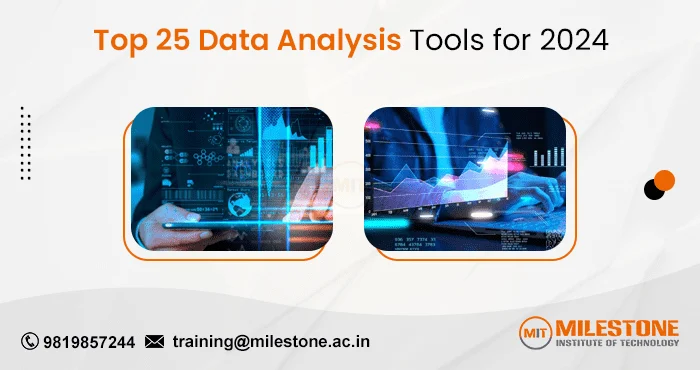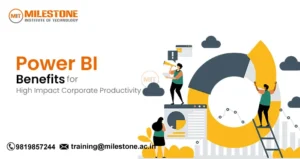Data analysis tools play an important role when it comes to transforming the raw data into meaningful and valuable insights which helps in making quality decisions. As we dive into 2024, there are huge requirements of strategies and tools with advanced capabilities in the market for data analysis. In this blog we will explore the
Top Data Analysis Tools for 2024 by understanding their features, use, and importance in today’s competitive world of data analytics and data science.
1. Python
Python is the most popular tool for
data analysis because it is flexible, easy to use, and contains a huge library (Panda, NumPy, SciPy).
What is the use of Python?
Python is basically used for many different purposes which includes data manipulation, scientific computing, numerical operations, machine learning, and many more. It is perfect for various data analysis tasks because of its vast ecosystem and readability.
Key Features:
- Extensive Libraries: Pandas for data manipulation, NumPy for numerical operations, SciPy for scientific computing.
- Versatility: Supports various data formats and integrates well with other languages and tools.
- Community Support: Large community contributing to libraries and resources.
2. R
R is a computer specialized language which is preferred for research, academic, graphics, and statistical computing because of its strong features of statistical analysis.
What is the use of R?
R language is used for predictive modeling, statistical analysis, data visualization, and data manipulation. Its has a wide range of features for specialized analytics tasks.
Key Features:
- Statistical Analysis: Comprehensive statistical functions and packages.
- Visualization: High-quality plots and graphs with packages like ggplot2.
- Community: Active community providing packages and support.
3. Tableau
Tableau is an excellent tool for data visualization which enables users to quickly and easily convert the complex data into interactive and more clear dashboard and visuals.
What is the use of Tableau?
Tableau is used for creating interactive dashboards and visualizations to explore and present data insights. It supports real-time analytics and integrates with numerous data sources.
Key Features:
- Interactive Dashboards: Drag-and-drop functionality for creating dynamic visualizations.
- Data Connectivity: Connects to databases, spreadsheets, and cloud services.
- User-Friendly Interface: Intuitive tools for users at all skill levels.
4. Microsoft Power BI
Microsoft Power BI is a robust business analytics tool that facilitates data visualization, sharing insights across an organization, and integrating seamlessly with other Microsoft products.
What is the use of Microsoft Power BI?
Power BI is used for creating interactive reports and dashboards, performing ad-hoc analysis, and sharing insights with stakeholders. It supports data modeling and real-time analytics.
Key Features:
- Interactive Visualizations: Rich visualizations with drill-down capabilities.
- Integration: Works well with Microsoft Excel, SQL Server, and other data sources.
- Data Preparation: Cleansing, transforming, and modeling data for analysis.
5. SAS
A complete analytics platform, SAS (Statistical Analysis System) is widely known for its strong statistical analysis, predictive modeling, and data management features.
What is the use of SAS?
SAS is used for advanced analytics, business intelligence, data mining, and predictive analytics across various industries, including finance and healthcare.
Key Features:
- Advanced Analytics: Strong machine learning algorithms and statistical techniques.
- Data Management: Data integration, cleansing, and transformation capabilities.
- Scalability: Handles large-scale data and complex analytical tasks.
6. Apache Spark
When it comes to choosing an open-source comprehensive analytics engine then Apache Spark is the most preferred and popular tool. This system analyzes massive amounts of data quickly, scales, and supports a variety of analytical activities.
What is the use of Apache Spark?
Apache Spark is used to handle data distributedly across batch processing, real-time streaming, machine learning, and SQL queries.
Key Features:
- Speed: In-memory computing for faster data processing.
- Versatility: Supports analytics tasks in several languages (Java, Scala, Python, R).
- Scalability: Scales from a single server to thousands of machines.
7. Excel
Excel remains a versatile data analysis tool, offering powerful features for data manipulation, visualization, and basic statistical analysis.
What is the use of Excel?
Data entry, editing, analysis, and visualization are all done in Excel. It supports formulas, pivot tables, charts, and integration with other Microsoft Office applications.
Key Features:
- Data Manipulation: Formulas and functions for data analysis and transformation.
- Visualization: Charts and graphs to visualize trends and patterns in data.
- Accessibility: Widely used across industries for data management and analysis tasks.
8. Google Data Studio
Google Data Studio is a free data visualization tool that helps users create interactive dashboards and reports from various data sources.
What is the use of Google Data Studio?
Google Data Studio is used for visualizing data, creating customizable dashboards, and sharing insights across teams. It integrates seamlessly with Google products and other data sources.
Key Features:
- Interactive Reports: Create dynamic, interactive reports and dashboards.
- Data Connectivity: Connects to Google Analytics, Google Ads, databases, and more.
- Customization: Customize visualizations and dashboards to suit specific needs.
9. Jupyter Notebook
Jupyter Notebook is an open-source web tool that lets users create and share documents with narrative text, equations, live code, and visualizations.
What is the use of Jupyter Notebook?
Jupyter Notebook is used for interactive data analysis, data visualization, machine learning, and collaborative work in various programming languages.
Key Features:
- Interactive Computing: Execute code interactively and display results in real-time.
- Visualization: Embed charts, plots, and multimedia content alongside code.
- Collaboration: Share notebooks for reproducible research and collaborative projects.
10. MATLAB
MATLAB is a high-level programming language and interactive environment for numerical computation, visualization, and algorithm development.
What is the use of MATLAB?
MATLAB is used for mathematical modeling, simulation, data analysis, and algorithm development in engineering, science, and finance applications.
Key Features:
- Numerical Computation: Extensive library of mathematical functions and toolboxes.
- Visualization: To visualize data and examine trends, create 2D and 3D graphs.
- Application Development: Develop custom applications using MATLAB Compiler and MATLAB Builder.
11. KNIME
The open-source
data analytics, reporting, and integration tool KNIME (Konstanz Information Miner) allows the visual design of data processes.
What is the use of KNIME?
KNIME is used for data blending, preprocessing, analysis, and visualization through a graphical user interface (GUI). It enables the integration of several data sources and machine learning algorithms.
Key Features:
- Visual Workflows: Drag-and-drop interface for creating data workflows without coding.
- Extensibility: Large collection of plugins and integrations for diverse analytical tasks.
- Community Support: Active community for sharing workflows, plugins, and knowledge.
12. RapidMiner
RapidMiner is a data science platform that offers tools for data preparation, machine learning, deep learning, text mining, and predictive analytics.
What is the use of RapidMiner?
RapidMiner is used for data mining, predictive analytics, and machine learning model development. It provides an integrated environment for end-to-end data science projects.
Key Features:
- End-to-End Data Science: Tools for modeling, deploying, evaluating, and preparing data.
- Machine Learning: Built-in machine learning algorithms and model optimization tools.
- Text Analytics: Text mining capabilities for extracting insights from unstructured data.
13. QlikView
QlikView is a business intelligence platform that provides interactive analytics with memory-based data processing and visualization features.
What is the use of QlikView?
QlikView is utilized for assisted analytics, interactive dashboard building, and data visualization. It enables users to explore data associations and insights through in-memory processing.
Key Features:
- In-Memory Data Processing: Accelerated data processing for real-time analytics.
- Associative Data Model: Explore data relationships dynamically without predefined queries.
- Customizable Dashboards: Create personalized analytics applications and reports.
14. Looker
Looker is a data analytics platform that simplifies data exploration, visualization, and collaboration for data-driven decision-making.
What is the use of Looker?
Looker is used for exploring and visualizing data, creating dashboards, and sharing insights across teams. It integrates with data warehouses and supports real-time data analytics.
Key Features:
- Real-Time Insights: Access up-to-date data analysis and reporting capabilities.
- Data Integration: Connects with various data sources and cloud platforms.
- Collaboration: Share insights and collaborate on data-driven decisions.
15. Alteryx
Alteryx is a data analytics platform that provides tools for data blending, advanced analytics, predictive analytics, and workflow automation.
What is the use of Alteryx?
Alteryx is used for data preparation, blending data from different sources, predictive modeling, and workflow automation. It streamlines complex data processes for analysts and data scientists.
Key Features:
- Data Blending: For an in-depth examination, combine and integrate data from several sources.
- Predictive Analytics: Build, validate, and deploy predictive models without coding.
- Workflow Automation: For efficiency, automate routine data activities and procedures.
16. Databricks
Databricks is a unified data analytics platform that provides a collaborative environment for big data processing, machine learning, and real-time analytics.
What is the use of Databricks?
Databricks is used for scalable data engineering, data science, and machine learning tasks on Apache Spark. It integrates collaborative analytics and data processing into one platform.
Key Features:
- Unified Analytics: Integrated environment for data engineering, data science, and analytics.
- Collaboration: Real-time collaboration on projects and insight sharing are possible.
- Scalability: Handle large-scale data processing and analytics with Apache Spark.
17. Sisense
Sisense is a business intelligence platform that allows users to prepare, analyze, and visualize complex data sets using its robust analytics tools.
What is the use of Sisense?
Sisense is used for data preparation, analysis, and visualization. It enables users to create interactive dashboards and reports to uncover insights and make data-driven decisions.
Key Features:
- Data Visualization: Create interactive visualizations and dashboards with drag-and-drop functionality.
- Data Modeling: Build data models and perform complex calculations for analysis.
- Embedded Analytics: Integrate analytics capabilities into applications and workflows.
18. PyTorch
For the purpose of creating and refining machine learning models, Google created the well-known open-source TensorFlow framework.
What is the use of PyTorch?
PyTorch is used for building and training deep learning models, including neural networks, natural language processing (NLP), and computer vision applications.
Key Features:
- Dynamic Computational Graphs: Define and modify computational graphs on-the-fly.
- GPU Acceleration: Use GPUs to accelerate inference and model training.
- Community Support: Active community and extensive libraries for machine learning research.
19. TensorFlow
Google created the well-known open-source TensorFlow machine learning framework, which is used to create and train machine learning models.
What is the use of TensorFlow?
TensorFlow is used for developing and deploying machine learning and deep learning models, including neural networks, reinforcement learning, and production-scale training.
Key Features:
- Flexible Architecture: Build models using high-level APIs like Keras or customize with TensorFlow’s core APIs.
- Scalability: Scale model training from a single machine to large clusters with TensorFlow Serving.
- Deployment: Deploy models in production with TensorFlow Extended (TFX) for end-to-end machine learning pipelines.
20. Splunk
Splunk is a platform that uses a web-style interface to search, monitor, and analyze massive data created by machines.
What is the use of Splunk?
Splunk is utilized for real-time monitoring, searching, and analyzing machine-generated data, including application logs, server logs, and network logs.
Key Features:
- Real-Time Insights: Monitor and analyze data streams in real-time.
- Search Capabilities: Strong indexing and search for fast data retrieval.
- Visualization: Create dashboards and reports to visualize data insights.
21. Minitab
Minitab is a statistical software package for quality improvement and statistical data analysis.
What is the use of Minitab?
Minitab is used for statistical analysis, hypothesis testing, regression analysis, and quality control in manufacturing, healthcare, and academia.
Key Features:
- Statistical Analysis: Conduct a wide range of statistical tests and analyses.
- Quality Improvement Tools: Tools like control charts, process capability analysis, and design of experiments (DOE).
- Ease of Use: User-friendly interface with guided workflows for statistical analysis.
22. IBM SPSS Statistics
IBM SPSS Statistics is a software package used for statistical analysis, data mining, and decision support.
What is the use of IBM SPSS Statistics?
IBM SPSS Statistics is used for statistical analysis, predictive modeling, data mining, and decision support in research, academia, and business.
Key Features:
- Advanced Analytics: Predictive modeling, regression analysis, and cluster analysis.
- Integration: Connects with various data sources for importing and exporting data.
- Automation: Automate repetitive tasks and generate reports for data-driven decision-making.
23. SAP Analytics Cloud
SAP Analytics Cloud is a cloud-based analytics program that unifies company data, planning, and predictive analytics into a single platform.
What is the use of SAP Analytics Cloud?
In SAP Analytics Cloud, we perform real-time analytics, conduct business intelligence activities, and collaborate on planning. It integrates with SAP and non-SAP data sources for comprehensive analysis.
Key Features:
- Business Intelligence: Create interactive dashboards and reports for data visualization.
- Predictive Analytics: Predictive modeling and forecasting capabilities for business insights.
- Planning: Collaborative planning and budgeting with integrated analytics and data visualization.
24. Domo
Domo is a cloud-based business intelligence platform that helps organizations optimize business performance and drive decision-making with real-time data insights.
What is the use of Domo?
Domo is used for data integration, visualization, and collaboration. It enables organizations to connect and consolidate data from multiple sources for comprehensive analysis.
Key Features:
- Data Integration: Consolidate data from various sources, including cloud applications and databases.
- Visualization: Create interactive dashboards and visualizations to monitor business metrics.
- Collaboration: Share insights and collaborate on data-driven decisions across teams.
25. Plotly
Plotly is a data visualization library for creating interactive plots and dashboards in Python, R, and JavaScript.
What is the use of Plotly?
With Plotly, you can create interactive visualizations including scatter plots, line charts, bar charts, and heatmaps. Support web-based interactive dashboards and reporting.
Key Features:
- Interactive Visualizations: Create interactive plots with hover, zoom, and pan functionalities.
- Multiple Programming Languages: Supports Python, R, and JavaScript for creating visualizations.
- Dashboards: Build web-based dashboards and reports for data-driven insights.
Frequently Asked Questions (FAQs)
Which data analysis tool is best for beginners?
Tools like Excel, Google Data Studio, and Tableau are great for beginners due to their user-friendly interfaces and extensive community support.
What are the benefits of using open-source data analysis tools?
Open-source tools like Python, R, and Apache Spark offer flexibility, community support, and cost-effectiveness, making them ideal for collaborative and innovative projects.
Which to learn these skill of data analytics?
When it comes to learning these crucial skills and techniques in the competitive world of
data science and data analytics, we will recommend the mostly recommended institute Milestone Institute of Technology which is famous for the quality trainings from experienced faculty where they focus on every student growth and career empowerment.
What factors should I consider when choosing a data analysis tool?
Consider factors such as your specific needs (e.g., data volume, complexity), ease of use, integration capabilities with existing systems, scalability, and support and training options when selecting a data analysis tool.




